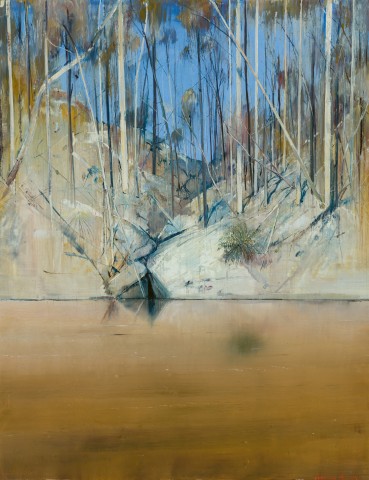CLEFT RIVERBANK WITH BUSH AND FERN, 1976
ARTHUR BOYD
oil on copper
31.0 x 24.0 cm
signed lower right: Arthur Boyd
Australian Galleries, Melbourne (label attached verso)
Joan Clemenger AO and Peter Clemenger AO, Melbourne, acquired from the above in 1976
Private collection, Melbourne, a gift from the above
Arthur Boyd, Shoalhaven River – Small Landscapes, Australian Galleries, Melbourne, 29 June – 13 July 1976, cat. 23
McGrath, S., The Artist and the Shoalhaven, Bay Books, Sydney, 1982, pp. 52, 126, 127 – 9 (illus.)
Eager to rediscover his roots, his ‘Australianism’, after more than a decade abroad, in 1971 Arthur Boyd returned to the country of his birth to take up a Creative Arts Fellowship at the Australian National University in Canberra. Over the blazing summer of 1971 – 72, Boyd and his wife Yvonne were invited by the Sydney art dealer Frank McDonald to visit Bundanon for the weekend, staying at a home he shared on the south coast of New South Wales with art historian Sandra McGrath and her husband Tony. Here the artist’s joyful rediscovery of the Australian bush with its stark contrasts and clarity of light was nothing short of an epiphany, and thus in 1974, Boyd purchased the nearby property Riversdale on the banks of the Shoalhaven River. Once again, the magic of the dour, untamed Australian landscape became the impetus for his art, and over the subsequent twenty-five years until his death in 1999, Boyd would dedicate himself almost exclusively to capturing the myriad moods of the Shoalhaven in images that are today imprinted upon the national psyche as some of our most beloved and iconic.
Soul-piercing in its beauty, the Shoalhaven region offered both refreshing solace for the artist’s world-weary eyes, and endless potential as a subject – ‘the variation in the area with its great deep tones and high keys’ bearing strong affinities with music. As Boyd elaborated, ‘in the desert there is only one note, just one low singing note. In this landscape the tonal range – not tonal in the obvious sense of colour, but the actual fact of the horizon which can vary from very high to low, to infinite, depending on your line of vision – makes it a greater challenge. It has a knife-edged clarity. Impressionism could never have been born here, but Wagner could easily have composed here.’1 Wild and primordial, the region differed completely from the ordered English countryside to which he had grown accustomed and thus, a new vision was required to unlock its tangled mysteries. If previously Breughel and Rembrandt had offered inspiration, now Von Guérard, Piguenit and Buvelot became Boyd’s spiritual mentors.
Significantly, among Boyd’s first works inspired by the Shoalhaven region was a series of miniature, jewel-like cabinet pictures on copper plate which he affectionately termed ‘little colour notes’ –elegantly encapsulated here by Cleft Riverbank with Bush and Fern, 1976, An unusual and highly original choice for an artist during the seventies – and especially one so accustomed to the immediacy and infinitely expressive potential of impasto painting – the oil on copper medium was an arduous pursuit, with each work requiring several weeks to complete and Boyd frequently suffering ‘tennis elbow’ as a result of painstakingly holding the brush across the painting to achieve maximum control of the miniature detail.1 Yet as Darleen Bungey elucidates in her compelling biography of the artist, the decision to embrace such a precise and time-consuming practice was a conscious one by Boyd; ‘While the big picture allowed him to ‘let off steam… hoping it would work’, copper necessitated that he deliberately ‘set about to make it work… It was as if he was choosing to rein himself in, to balance the scales between the wild expressionist paintings and works which would demand patience and a more formal technique.’2
Paying homage to both the Old Masters and the very ‘craft of painting’ itself, the copper plates were thus conceived as serious perceptual works – embodying an important period of ‘research’ that enabled the artist to glean valuable insights into the area and accurately record salient visual details for future exploration in his larger, more ambitious renderings of the Shoalhaven. A pensive, classically serene work, Cleft Riverbank with Bush and Fern offers a particularly charming example of these intimate copper endeavours which not only celebrate the artist’s wonder at the sheer beauty and grandeur of the Shoalhaven area, but eloquently attest to his reverence for his artistic predecessors. Suffused with warmth and lyricism, indeed the present acknowledges Boyd’s enormous debt in particular to eminent Australian impressionist, Tom Roberts, with the glowing, honey-coloured palette reminiscent of the Heidelberg master’s iconic Bailed Up! 1895 (Art Gallery of New South Wales) and the motif of the cleft riverbank, an obvious reference to Roberts’ In a Corner on the MacIntyre, 1895 (National Gallery of Australia). As Boyd himself reflected, ‘I found at Bundanon a particular rock formation that fascinated me, because the rock and its reflection in the water made a diamond shape. It reminded me of a Tom Roberts painting in which there is a bushranger and a horse drinking… It’s a wonderful painting – the key is as high as it can go and the relationships are perfect.’3
1. McKenzie, J., Arthur Boyd at Bundanon, Academy Editions, London, 1994, p. 28
2. Bungey, D., Arthur Boyd: A Life, Allen & Unwin, Sydney, 2008, pp. 497 – 498
3. Boyd cited in McGrath, S., The Artist and the Shoalhaven, Bay Books, Sydney, 1982, p. 79
VERONICA ANGELATOS
